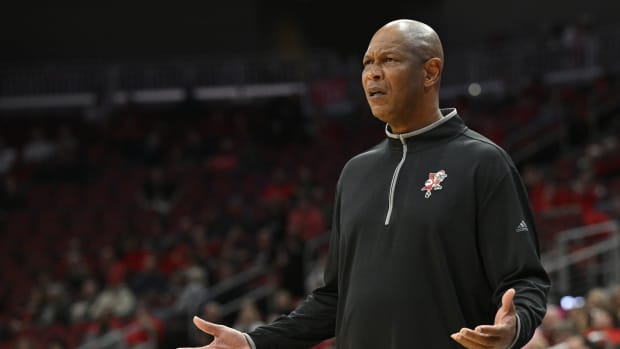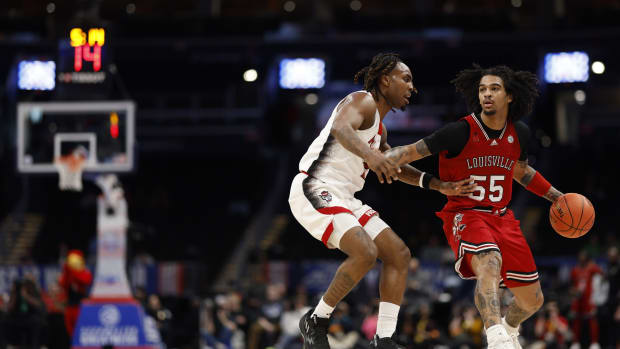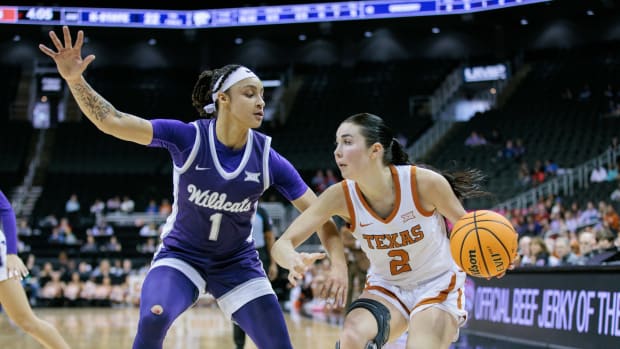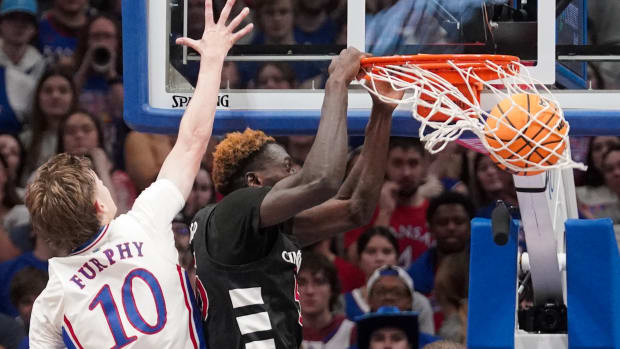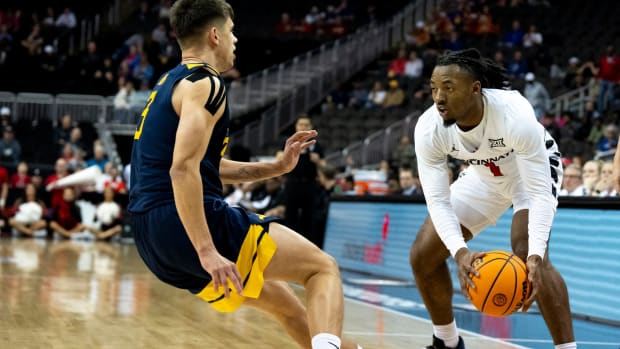Power Rankings: Analyzing the offenses of the NCAA tournament's likely No. 1 seeds
The final Power Rankings of the regular season take an in-depth look at the offenses of the four, projected No. 1 seeds for the NCAA tournament:
1. Kansas Jayhawks
(Projected No. 1 seed in Midwest Region; ranked 5th in adjusted offensive efficiency on kenpom.com)Offensive Scouting Report* This is the Season of Smallball in Lawrence. Kansas' run at the 2016 national title was killed by a smallballin' Villanova team in the Elite Eight, and the Jayhawks have subsequently joined in on the downsizing. It wasn't a matter of copycatting 'Nova; it was about KU coach Bill Self maximizing the potential of a roster with an abundance of guards and a potential Lottery Pick freshman wing, 6' 8" Josh Jackson, who has considerable college value as a creating-scoring-and-rebounding "small" four. Self went small on just a handful of possessions in '15–16, when his preferred 4–5 combo was senior Perry Ellis and junior Landen Lucas, and he had four playable bigs on the bench. This season, since losing freshman backup center Udoka Azubuike to an injury in mid-December, Self has rolled with small-ball units 88.6% of the time*, and it's resulted in the most efficient offense of his 13-season-run of Big 12 titles.*(Splits gathered from hooplens.com lineup data during that time period.)* The quintessential Kansas possession this season is the smallball weave, where the four perimeter players execute a series of dribble handoffs, with occasional ballscreen-and-roll-to-the-post actions by the lone big. While the Jayhawks' national player of the year candidate, point guard Frank Mason III, is a capable scorer in pretty much any situation—isolations, ballscreens, handoffs, catch-and-shoots—Jackson is an abysmal iso scorer (at just 0.48 points per possession, according to Synergy) and not much better as a pick-and-roll ballhandler (0.59 PPP). That makes the weave ideal for Jackson, because it either gives him downhill driving momentum off of a handoff …… or sets him up to make backcuts to the rim, which he typically finishes better than this one:* Having a second point guard (Devonte' Graham) on the floor and mixing up ballhandlers with the weave creates more catch-and-shoot opportunities for Mason than a typical floor general gets. And that's a good thing, because Mason is one of the nation's most efficient catch-and-shoot snipers, scoring a remarkable 1.65 PPP. Aside from a wide-open lob dunk for Jackson, Mason firing off the catch is Kansas' most valuable scoring option.* Posting up isn't completely dead for Kansas. While it's no longer consistently option A or B, Lucas did have seven post-up possessions in the regular-season finale against Oklahoma State. He's an efficient enough post scorer (at 1.00 PPP) to have sets run for him when he's matched up against a lesser big man, and the Jayhawks' spread-out offense, which always has four long-range shooters, makes it difficult to run double-teams at Lucas on the block.
2. Villanova Wildcats
(Projected No. 1 seed in East Region; ranked 3rd in adjusted offensive efficiency on kenpom.com)Offensive Scouting Report* Villanova is the one elite offense that out-smallballs Kansas, often rolling with some combination of the 6' 6" Kris Jenkins at the four, and 6' 7" Eric Paschall or 6'7" Mikal Bridges at the five. Partly due to an injury that kept starting "center" Darryl Reynolds out for five Big East games, the Wildcats used those super-small combos 49.7% of the time during conference play, with positive offensive results, according to hooplens.com data. No overhaul has been necessary to go super-small: Coach Jay Wright has been running four-out motion offense forever at 'Nova, and his attack easily adapts to five-out arrangements that create wide-open spaces for drives. * 'Nova sets up a lot of those drives with its favorite maneuver, the shot-fake. I ran this earlier in the season, but when FS1 showed a glimpse of Providence coach Ed Cooley's locker-room whiteboard prior to his first meeting with Villanova, the first point of emphasis under Jenkins and guards Jalen Brunson and Dante DiVincenzo was "stay down on shot fakes." * The signature move for national player of the year candidate Josh Hart, a right-handed wing, is to drive left from the perimeter and spin back right for a layup. Hart is arguably the country's most effective driving-to-the-rack scorer, and the quintessential Villanova possession looks pretty much like this one in a later meeting with the Friars: spread to set up a Brunson drive, jump-stop, shot-fake and kickout; followed by a Hart catch, shot-fake, drive left and spin-back right:You can scout it all you want, but you still can't stop it. * While Hart is rightfully getting Wooden and Naismith award buzz, the biggest reason Villanova hasn't experienced any drop-off offensively from its national-title season—it ranked third in adjusted efficiency then, and is third this year—is Brunson's sophomore-year improvement. He was a sub-1.00 PPP backup in Big East play as a freshman, and now he's the league's most efficient point guard by a pretty wide margin. Take a look at how much he's improved:* While I wouldn't classify Villanova as a running team—they end just 16.2% of their possessions in transition—they're highly effective when they do seize the opportunity to fastbreak. The 1.29 PPP they score in transition is second nationally only to Saint Mary's, and Hart in particular is a killer; he rarely fails to produce points with his basket attacks, averaging 1.40 PPP on the break.
3. Gonzaga Bulldogs
(Projected No. 1 seed in West Region; ranked 9th in adjusted offensive efficiency on kenpom.com)Offensive Scouting Report* The Zags have the best inside/outside balance of any of the No. 1s. They have a point guard (Nigel Williams-Goss) who can carry their offensive if necessary, and multiple shooters around him to spread the floor (Jordan Mathews and Josh Perkins), but they make a concerted effort to feed the ball into the blocks and take advantage of their two elite post scorers (senior center Przemek Karnowski and his freshman backup, Zach Collins). * The Zags' interior focus makes them the third most post-centric team in the nation; 24.7% of their possessions end on post-ups or passes out of the post. They're also the most efficient, high-volume post team in the nation, averaging 1.16 PPP on those possessions, per Synergy.* Their quintessential possession this season, then, is what they call "point-to-post"—push the ball up the floor after a make, see if the giant Karnowski can get early position, feed him the ball, and let him drop in his signature, lefty hook:The beauty of Karnowski is that you can't stop the hook 1-on-1, but if you send a double-team at him, he destroys you with his elite passing skills, like this:* While Gonzaga has those aforementioned shooters—Williams-Goss, Mathews, Perkins and Silas Melson are all regular threats from deep—its overall 3-point rate (the ratio of 3PAs/FGAs) has been trending downward into March. In the non-conference season, the Zags frequently had five-game running 3-point rates of 35% or higher; lately they've been in the high 20s. I'll be curious to see if that changes during the NCAA tournament.
4. North Carolina Tar Heels
(Projected No. 1 seed in South Region; ranked 4th in adjusted offensive efficiency on kenpom.com)Offensive Scouting Report* The Tar Heels' transition game is not what it used to be. Normally I wouldn't start out on a negative, given how well Carolina has been able to score this season … but running is central to Roy Williams teams' offensive identity, and this is the first season UNC has scored less than 1.00 PPP in transition. It's not running any less than usual, but it's generating fewer points, per Synergy:(The root cause of this was losing Marcus Paige and Brice Johnson to graduation; they were the two best transition finishers from last year's starting lineup.)* So: How are the Heels still an elite offensive team? To start, they own the offensive glass, by grabbing 42.4% of their missed shots—the highest offensive board rate by a UNC team since Tyler Hansbrough's junior season of '07-08. Kennedy Meeks, Tony Bradley, Luke Maye and Isaiah Hicks are a four-headed monster in this regard, as Williams prefers to play big and have two of them on the floor at almost all times.* The quintessential UNC possession in 2016–17, then, is one of my favorite examples of backboard volleyball: A sequence from the first half of their home win over Louisville that starts with the Heels running motion, then feeding Meeks on the left block, him missing a hook … and it being followed by FOUR put-back attempts, which eventually result in a bucket:* The other way UNC is compensating for being less of a transition power is with improved and higher-volume long-range shooting. Its three-point rate is up from 26.7% last season to 30.0% this season, and its accuracy has increased from 32.7% to 37.0%. The big driver of this is breakout junior star Justin Jackson, who's seen huge gains in accuracy by fixing his mechanics, and has leveraged his newfound jump-shooting efficiency by taking threes at almost twice the rate he did as a sophomore:5. Oregon 6. UCLA 7. Kentucky 8. Baylor 9. Louisville 10. Arizona 11. Duke 12. Butler 13. West Virginia 14. Purdue 15. Florida State 16. Notre Dame 17. Virginia 18. Florida 19. SMU 20. Iowa State 21. Cincinnati 22. St. Mary's 23. Oklahoma State 24. Wisconsin 25. Wichita State 26. Miami 27. Minnesota 28. Dayton 29. Maryland 30. Michigan 31. Creighton 32. UNC Wilmington




